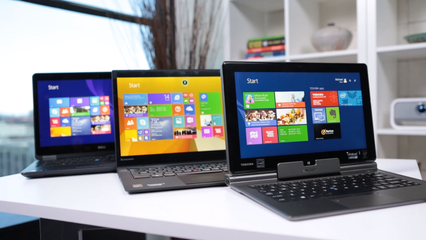There are a number of smaller Windows tablets hitting the shelves now from Microsoft OEM partners and more on the horizon. At face value it seems like a late attempt by the Windows ecosystem to get in on the mobile device game. The reality, though, is that Microsoft can still capture a respectable—possibly dominant—stake of the tablet market.

I can hear the uproar already, but let’s look at why that might not be so crazy. Here are five reasons a small Windows tablet makes sense, and why you might find yourself owning one very soon.
1. Functionality
Apple’s iPads and the myriad Android tablet options out there are plenty capable, but they’re not Windows. The Windows operating system still owns more than 90 percent of the desktop OS market, which means that the vast majority of iPad and Android tablet owners are faced with trying to find native apps that do what they want and figuring out how to keep data synced between the platforms. A small Windows tablet is—beneath its tiny tablet exterior—a fully-functional Windows PC, which means that the features and functions will be familiar, and users won’t have to learn two separate platforms.
2. Software
It’s true the iOS and Android app stores have far more apps than the Windows or Windows Phone app stores. But most of those are games or other entertainment apps. Among the apps that matter when it comes to getting things done, many are intended to mimic or emulate popular tools already available for Windows. Why waste time searching for an imitation when you can have the real thing?
3. Integration
The availability of services like OneDrive and Box across all the major platforms has made this much less of a consideration than it once was. There are still some occasional hurdles, however, when it comes to integrating the work and data from an iOS or Android mobile device with a Windows PC. A Windows tablet nullifies this problem, allowing you to move from PC to tablet seamlessly.
4. Mobility
This is what you buy a tablet for, right? You want a device you can use to check Twitter while watching TV in the living room, look up sports scores while standing in the kitchen, or read a book while lying in bed. The added benefit of having a small Windows tablet, though, is that it also enables you run that proprietary sales application while sitting in a conference room.
5. Price
This is arguably the point that matters most. The Surface Pro 3 is a phenomenal device, but with a starting price of $800 it’s far too lofty for use as a secondary device. Most average consumers can’t afford to spend even $200 or $300 on a device that will only augment their existing PC. But as Android has proven, there is tremendous demand for a small, affordable tablet.
If Microsoft OEM partners can produce tablets of good quality and performance in the $100 to $150 range, Windows could quickly replace Android as the platform of choice for inexpensive tablets.
Original from: pcworld.com
More useful tips: